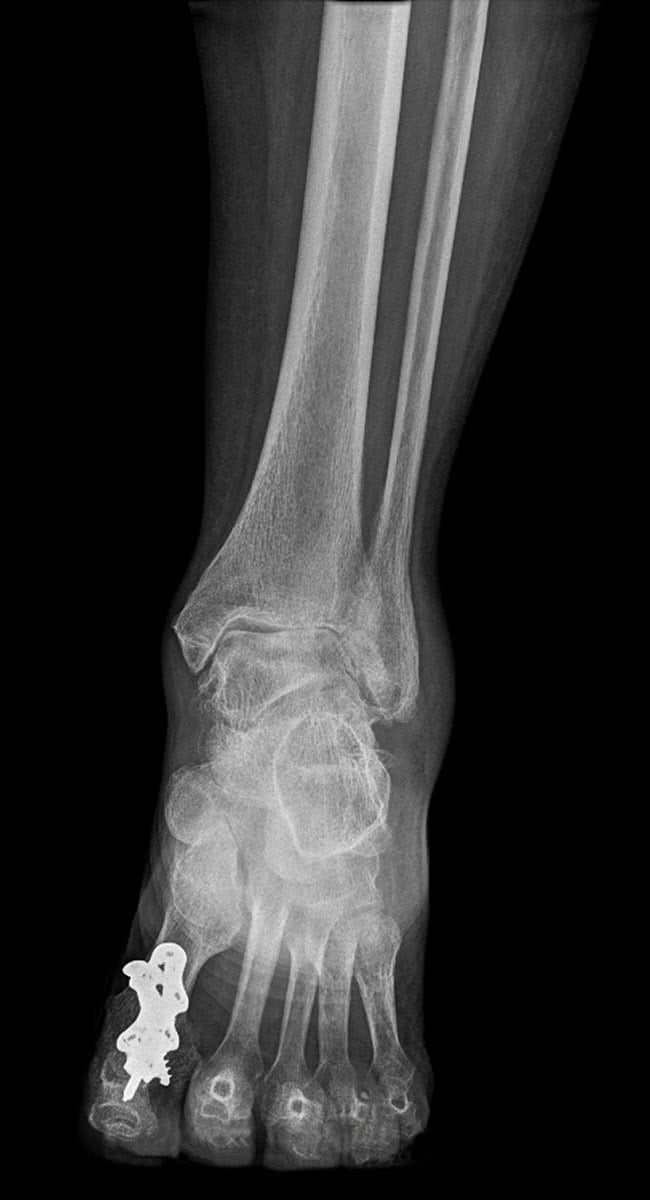Introduction
Arthritis, which describes inflammation in the joints in the body, is relatively common in the feet and in ankles.
Arthritis is a collective term for over a hundred different types of conditions involving inflammation in joints, and is also common in the hip and knee joints.
Any arthritis will cause a degree of stiffness and pain in the joint, from mild to severe, and as a result affects all sorts of normal daily activities.
There is no cure for arthritis, however there are a range of treatment options.

Types of arthritis affecting the ankle
Osteoarthritis
This type of arthritis is caused by the wearing away of the cartilage between the bones. This is a degenerative disease and so affects older people (i.e. older than 50) more than younger people.
Rheumatoid arthritis
This type of arthritis is a form of auto-immune disease, where the body's own immune system attacks its own tissue, affecting the bone, the cartilage and the ligaments as well as the synovial membrane, which surrounds the joint. It tends to impact more than one joint and is 'symmetrical’, that is it tends to affect the joints on one side of the body only.
There is also a type of rheumatoid arthritis affecting children, termed Juvenile Rheumatoid Arthritis (JRA). It presents quite differently from the adult variety and is treated differently too.
Post traumatic arthritis
This term refers to arthritis that develops after injury (ie trauma, such as dislocations or fractures) to the foot and/or ankle. The injuries can be to the cartilage (meniscus), the ligaments or the bone or a combination of these, and symptoms of arthritis can take a long time to appear after the initial injury. The likelihood of arthritis developing in a joint that has previously sustained an injury is seven times greater than with a joint that has not.
These three types of arthritis are the commonest types affecting ankles. Other less common conditions include…
Gout
Gout is inflammation of the joints caused by an excess of uric acid in the body, which then forms as small crystals in the joints. It particularly affects the big toe, but can affect other joints. Men are more prone to the condition than women and older people more than younger people.
Reactive arthritis
This can occur after a case of infection affecting the gastrointestinal system or the urinary tract or genital area. The ankle, knee and foot tend to be the most affected by this type of arthritis.
Psoriatic arthritis
This type is associated with the skin disease psoriasis. It tends to affect the ankle and can occur either before or after the appearance of the skin condition.
Infectious arthritis
Infectious arthritis is sometimes called ’septic arthritis’. This is associated with an infection in the joint itself, caused by bacteria in the bloodstream or in some cases a fungal or viral infection. When it occurs, the ankle is often affected.
Causes
Medical science has not yet discovered the precise cause or causes of arthritis – however evidence points to one or more of the following being contributory factors…
- Injury to the joint.
- Inherited defects in the bone or cartilage in the joint.
- Genetic makeup making some people more susceptible to the condition.
- Deterioration of the cartilage tissue with age.
- Weakness in muscles/tendons/ligaments around the joint.
- Greater strain placed on the joint by e.g. being overweight / obese or regularly taking part in some types of sporting activities.
Symptoms
Symptoms of arthritis in the ankle include...
- Pain or stiffness of the ankle particularly noticeable...
- First thing in the morning.
- After long periods of being seated.
- Going up or down stairs.
- When walking.
- Swelling of the joint.
- Instability of the joint i.e. where it feels as if it might give way.
- Inability to either straighten or flex the joint.
In most cases, symptoms appear gradually over time and get worse, although sudden onset of symptoms can occur. The weather can also impact symptoms, getting worse often during damp weather. In almost all cases of ankle arthritis, being overweight makes symptoms worse and simply reducing weight will generally alleviate them.
Tests / Diagnosis
A physical examination and review of medical history will allow an initial diagnosis. Your doctor may also ask to see your shoes to check for any uneven wear and to see if they are providing adequate support for your foot and ankle. They may want to observe you as you walk in an examination called ‘gait analysis’.
Further tests may be needed to confirm any diagnosis. These may include...
X-rays
X-rays will show any changes to bone structure, such as bone spurs (called 'osteophytes') and will indicate which type of arthritis is present. These x-rays are taken while you are standing up, which allows better visualisation of the bones when they are load-bearing
MRI / CT / Bone scans
These may be necessary to visualise bone density and to analyse soft tissues in the affected joint(s).
Blood tests will also help to determine the type of arthritis present.
Non-operative Treatment
Knee arthritis can often be managed with a combination of non-surgical treatments. Your General Practitioner will be able to help with the implementation of these. Some options include:
- Gait aids such as walking sticks or frames.
- Ankle braces, splints such as an Ankle Foot Orthosis (AFO), orthotics or specialist footwear known as rocker sole shoes.
- Physio or hydrotherapy, exercise programs designed to keep you mobile.
- Paracetamol or Non-Steroidal anti-inflammatory medications.
- Supplements such as fish oil, turmeric extract, or a specific anti-inflammatory diet.
- Losing weight if you are overweight.
Excellent information is available at Arthritis Australia.
Related Information
Anatomy of the Foot and Ankle
Ankle Fusion
Ankle Replacement (TAR)
Arthritis of the Foot and Ankle
